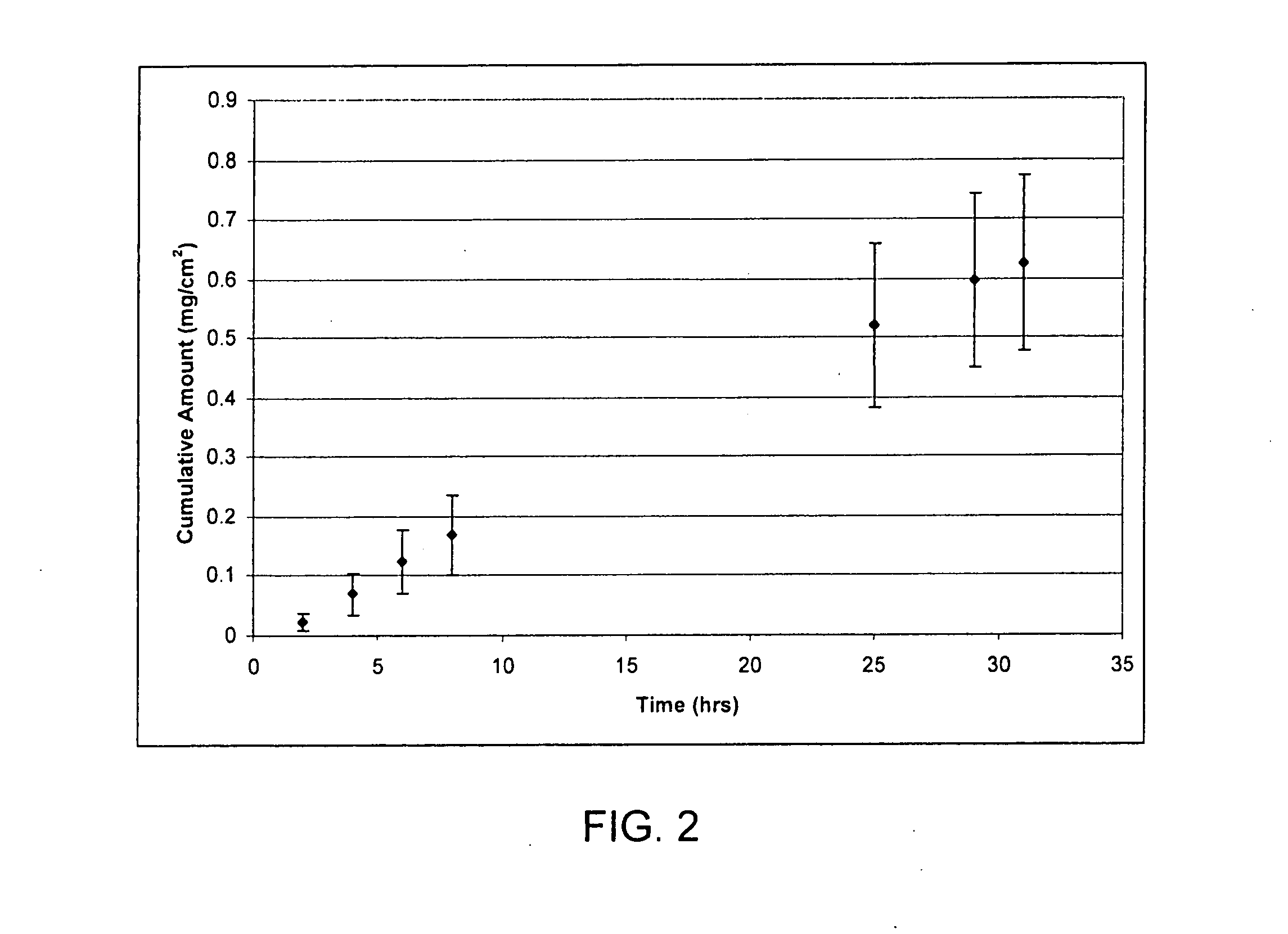Adhesive solid gel-forming formulations for dermal drug delivery
- Summary
- Abstract
- Description
- Claims
- Application Information
AI Technical Summary
Benefits of technology
Problems solved by technology
Method used
Image
Examples
example 1
Skin Permeation Methodology
[0097] Hairless mouse skin (HMS) or human epidermal membrane is used as the model membrane for the in vitro flux studies described in herein. Freshly separated epidermis removed from the abdomen of a hairless mouse or previously prepared human epidermal membrane samples are mounted carefully between the donor and receiver chambers of a Franz diffusion cell.
[0098] The receiver chamber is filled with pH 7.4 phosphate buffered saline (PBS).
[0099] The experiment is initiated by placing test formulations (of Examples 2-5) on the stratum corneum (SC) of the skin sample. Franz cells are placed in a heating block maintained at 37° C. and the HMS temperature is maintained at 35° C. At predetermined time intervals, 800 μL aliquots are withdrawn and replaced with fresh PBS solution. Skin flux (μg / cm2 / h) is determined from the steady-state slope of a plot of the cumulative amount of permeation versus time. It is to be noted that human cadaver skin is used as the mo...
example 2
[0100] Formulations of acyclovir (obtained from Uqufia) in various non-volatile solvent systems are evaluated. Excess acyclovir is present in all the formulations in this example to maximize the permeation driving force.
[0101] The permeation of acyclovir from the test formulations through HMS are presented in Table 4 below.
TABLE 4Skin Flux*Non-volatile solvent system(μg / cm2 / h)Polyethylene glycol 4000Isostearic acid 0.1 ± 0.09Isostearic acid + 10% trolamine2.7 ± 0.6Isostearic acid + 30% trolamine7 ± 2Oleic acid0.4 ± 0.3Oleic acid + 10% trolamine3.7 ± 0.5Oleic acid + 30% trolamine14 ± 5 Span 80 (sorbitan monooleate)0.07 ± 0.03Ethyl oleate0.2 ± 0.2Ethyl oleate + 10% trolamine0.2 ± 0.2
*Skin flux measurements represent the mean and standard deviation of three determinations. Flux measurements reported were determined from the linear region of the cumulative amount versus time plots. The linear region was observed to be between 4-8 hours. If experimental conditions allowed, the steady-...
example 3
[0103] Formulations of ketoprofen (obtained from Cosma) in various non-volatile solvent systems are evaluated. Excess ketoprofen is present. The permeation of ketoprofen from the test formulations through HMS is presented in Table 5 below.
TABLE 5Skin Flux*Non-volatile solvent system(μg / cm2 / h)Glycerol2 ± 1Polyethylene glycol 4005 ± 2Span 20 (sorbitan laurate)15 ± 3 Propylene glycol90 ± 50Oleic acid180 ± 20
*Skin flux measurements represent the mean and st. dev of three determinations. Flux measurements reported were determined from the linear region of the cumulative amount versus time plots. The linear region was observed to be between 4-8 hours.. If experimental conditions allowed, the steady-state delivery would likely continue well beyond 8 hours.
[0104] Steady state flux of ketoprofen from the above non-volatile solvents are obtained by placing 200 mcL on the stratum corneum side (donor) of hairless mouse skin. The in vitro studies are carried out as described in Example 1. Fr...
PUM
| Property | Measurement | Unit |
|---|---|---|
| Fraction | aaaaa | aaaaa |
| Time | aaaaa | aaaaa |
| Thickness | aaaaa | aaaaa |
Abstract
Description
Claims
Application Information
 Login to View More
Login to View More - R&D
- Intellectual Property
- Life Sciences
- Materials
- Tech Scout
- Unparalleled Data Quality
- Higher Quality Content
- 60% Fewer Hallucinations
Browse by: Latest US Patents, China's latest patents, Technical Efficacy Thesaurus, Application Domain, Technology Topic, Popular Technical Reports.
© 2025 PatSnap. All rights reserved.Legal|Privacy policy|Modern Slavery Act Transparency Statement|Sitemap|About US| Contact US: help@patsnap.com


